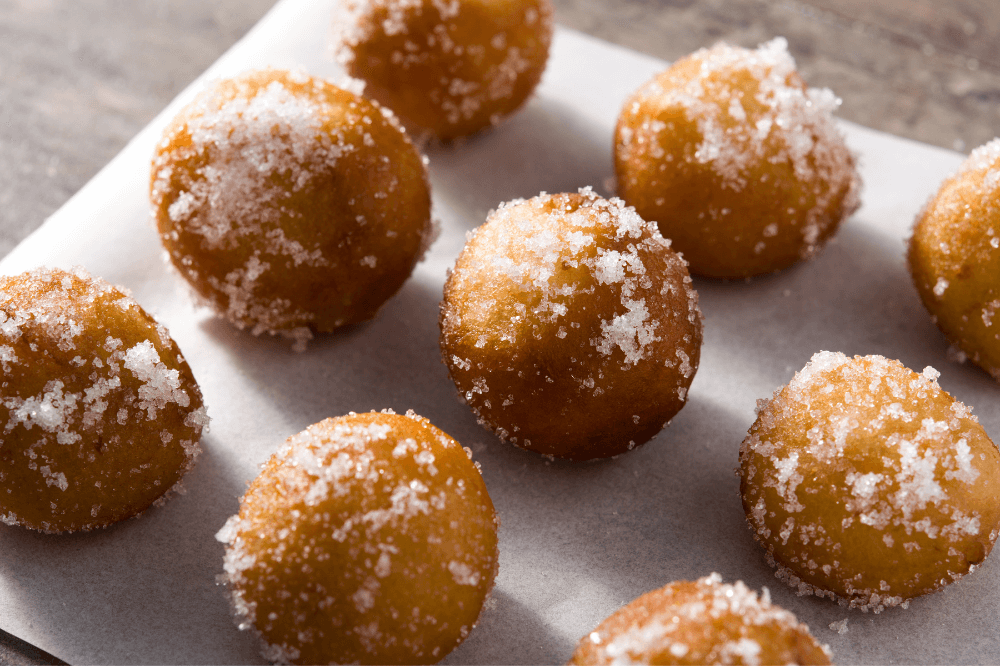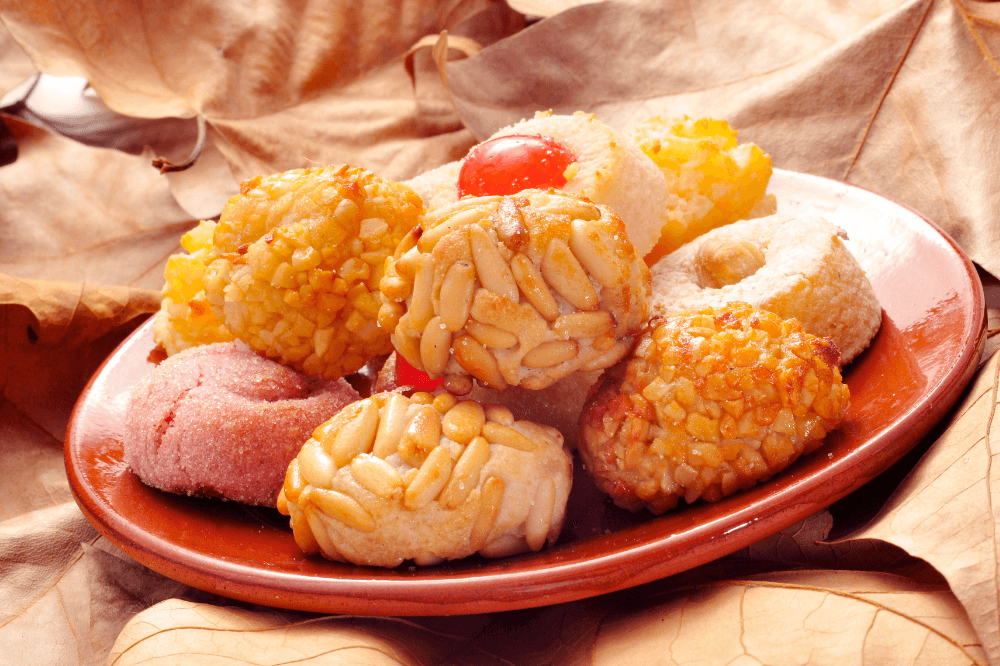Autumn in Spain doesn’t just bring warm colors and cooler temperatures, it also marks one of the country’s most deeply rooted traditions: the celebration of All Saints’ Day.
And with it comes a true pastry festival.
These seasonal sweets are much more than desserts: they’re acts of love, a connection to our grandmothers, and often the perfect excuse to gather with loved ones.
If you want to discover the most traditional All Saints’ Day desserts, we’ve put together this guide so you don’t miss a single treat found in bakeries, convents, and homes.
A legacy of sweetness that will let you experience the All Saints’ tradition like a true local.
The 7 Most Traditional Spanish Desserts for All Saints’ Day
While in other cultures this date is filled with pumpkins and costumes, here in Spain we honor the memory of those who are no longer with us through warmth, spiced aromas, and yes a generous dose of sugar.
1. Huesos de Santo
They are, without a doubt, the star of pastry shops when All Saints’ Day (November 1st) arrives.

First, their name comes from their cylindrical, whitish shape, which resembles small human bones, a very fitting symbol for a holiday dedicated to remembering the departed.
Their origin is very old (dating back to the 17th century) and they are linked to the tradition of convent-made sweets.
As for their composition, they’re quite a rich treat but exquisite.
The base is marzipan, a sweet paste made primarily from ground almonds and sugar, though the key lies in the filling.
The traditional version is filled with yema, a thick, intense cream made from egg yolks and sugar, which creates a delicious contrast between the soft texture of the marzipan on the outside and the creamy filling inside.
And while today you can find them with more modern fillings like chocolate, coconut, or truffle, the classic yema version is the one to try if you want to appreciate the true essence of the tradition.
As a curious fact, unlike buñuelos de viento which are fried, Huesos de Santo are briefly baked to set the marzipan.
2. Buñuelos de Viento
This is the lightest and most popular sweet of the celebration, and its origin is slightly older than that of the Huesos de Santo.

According to tradition, buñuelos originated in the Moorish community of Granada, though it was convents and monasteries that popularized them and firmly associated them with All Saints’ Day.
There’s also a lovely legend: for each buñuelo we eat, a soul is freed from Purgatory, so they carry a powerful symbolism of lightness and liberation.
In terms of composition, they’re a simple and humble dessert, but one that requires a clever technique.
The base is a choux pastry (like that used for eclairs), made with flour, water, butter, and eggs, and fried in plenty of oil.
Their nickname, “de viento” (wind-blown), comes from the way the dough puffs up when fried and becomes completely hollow inside, as if filled only with air.
Traditionally, they’re served just dusted with sugar, but nowadays the most common versions are filled with whipped cream, pastry cream, or chocolate.
And just like Huesos de Santo, Buñuelos de Viento are a national phenomenon.
You can find them across Spain from Madrid to Andalusia to Catalonia making them the quintessential pan-fried sweet of the season.
Tip: try the ones filled with cream or whipped cream the contrast between the warm, fluffy dough and the cold filling is a real delight.
Explore our experiences with local cooks en Madrid.
3. Panellets
If buñuelos de viento and huesos de santo are the national duo, Panellets are without a doubt the regional gem you need to discover.

These are sweets with a very strong geographical identity, as they originate from Catalonia and are considered the star dessert of the La Castanyada celebration.
Fortunately, you can also find them in nearby regions like Aragon, Valencia, and the Balearic Islands.
It’s important to know that, historically, they were eaten at the end of gatherings dedicated to honoring the departed, usually accompanied by roasted chestnuts and sweet wine.
In terms of preparation, they’re very similar to Huesos de Santo, but shaped like small balls or patties.
The key lies in the base, made of ground almonds and sugar, to which a bit of sweet potato or boiled potato is often added to give them a softer, moister texture.
The most traditional and beloved panellet is the pine nut version, where the marzipan ball is completely coated in this nut before baking.
However, you’ll find many flavors from the classic almond and coconut to coffee, quince, and even chocolate.
Do keep in mind that, because of the almonds and pine nuts, they’re a fairly dense and nutritious sweet.
Perfect to pair with a glass of moscatel, the traditional sweet wine of the region.
4. Sweet Gachas or Gachas de los Santos
This is a very humble and comforting dessert, with its origins in ancient Andalusian (Andalusí) cuisine.
It’s very typical in the south of Spain, especially in the eastern provinces of Andalusia like Jaén, Córdoba, and Granada, although it goes by different names depending on the region: in western Andalusia they’re called Poleás, and in Almería, Talvinas.
And just like the buñuelos, this dish comes with a beautiful legend: it’s said that eating gachas on this day helps you become more attractive for the rest of the year.
As for its composition, the base is flour (first toasted in extra virgin olive oil), milk, and sugar.
The key lies in the flavoring: the oil is infused with anise seeds (matalahúva), cinnamon sticks, and often a piece of lemon peel.
All of this is topped with crispy croutons or fried bread cubes, which add a very pleasant contrast in texture.
5. Pestiños
Next on the list is another favorite from Andalusian pastry traditions that has been fully integrated into our celebrations: pestiños.

Although it’s quite versatile in the calendar and while it’s enjoyed during All Saints’ Day, it’s also eaten at Christmas and, most of all, during Holy Week.
As for the ingredients, the dough is made with flour, extra virgin olive oil, and white wine or sherry, and it’s flavored with spices that give it an unmistakable aroma:
- Sesame seeds (ajonjolí).
- Anise seeds (matalahúva).
- Fried orange or lemon peel.
The dough is then cut into squares, folded, and fried in plenty of oil, which gives it its light and crispy texture.
The final key to a good pestiño is in the coating.
Traditionally, they’re served drenched in a thick, warm honey glaze. However, you’ll also find them dusted with sugar and cinnamon, or topped with a light syrup.
Explore our experiences with local cooks in Alicante.
6. All Saints’ Day Rosquillas
The circle of fried sweets is completed with rosquillas de Todos los Santos, a dessert that shares roots and simplicity with pestiños and buñuelos.

The origin of rosquillas is ancient the ring shape of fried pastries dates back to the Roman Empire.
In Spain, rosquillas have been adapted to countless celebrations, but the ones eaten during this season are a variation of the traditional rosquillas de anís, very popular in central Spain, especially in Castile and León.
As for their composition, they’re made from a fried (or sometimes baked) dough consisting of flour, eggs, oil or lard, and anise liqueur.
Traditionally, they’re finished with a sugar and anise glaze, which makes them crunchy on the outside and soft on the inside.
You can find them across almost all regions of Spain, though we recommend looking for the handmade versions from convents or traditional bakeries, as they best preserve the essence of that classic anise flavor.
7. Hojuelas (or Fiyuelas / Huesillos Extremeños)
To wrap up this delicious list, we head to Extremadura and Castilla-La Mancha to talk about Hojuelas, also known in some areas as Huesillos or Fiyuelas.
This is a very simple dough, made with flour, eggs, oil, and anise liqueur or aguardiente, but the magic lies in the technique: the dough must be stretched until it’s almost transparent like a sheet of paper.
This thinness creates a special effect when fried in plenty of oil: the dough wrinkles, ripples, and turns incredibly crispy and light, almost like edible lace.
The most traditional way to serve them is to bathe them in a honey syrup or, more commonly, to dust them with sugar and cinnamon, or drizzle them simply with honey.
It’s a sweet that’s traditionally made in large batches at home to give to neighbors and friends.
So, if you’re traveling through Extremadura or southern Castilla-La Mancha during these dates, there’s a good chance someone will offer you a taste.
Live the Most Authentic Tradition with Sazón The Folk Cook
After this sweet journey, you now know all the names and flavors to enjoy All Saints’ Day like a true local.
But if the origins, legends, and ingredients of these treats have sparked your curiosity, it means it’s time to take the final step: not just to eat them, but to experience them.
At Sazón, we believe that the true culture of our country is cooked and shared unfiltered.
That’s why we invite you to go beyond the bakery counter.
Imagine tasting freshly made buñuelos, crispy pestiños, straight from the kitchen of a local cook who has inherited and lovingly preserved these recipes with the care of a grandmother or a mother.
That’s the beauty of Sazón: opening the doors of a Spanish home so that, beyond tasting the most traditional seasonal dishes, you can live like a local even if just for a few hours.
If you want to truly know our culture in all its depth, the real experience awaits you at the table.
Dare to book your Sazón experience with a local cook and turn this trip into an authentic connection with our gastronomic tradition.
Explore our experiences with local cooks.






